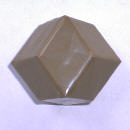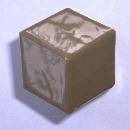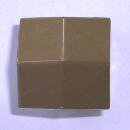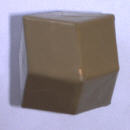Faceting Sphalerite!
Following a discussion on
"PaulAhlstedt - YahooGroup" I have compiled this
overview on "Faceting Sphalerite" with the comments by
Paul Ahlstedt and me. You can se the entire thread here.
This is a summary of what you can
find on Sphalerite in most mineral text books.
|
| Chemistry |
Sphalerite
is a naturally occuring mineral made up of Zinc Sulphide.
In nature there's invariably some amount of iron in the
crystal, but also barium. Sphalerite is one of the base
ores of mining.
As a curiosum, Sphalerite with germanium is one of the
main sources for this metal. |
| Hardness |
Hardness
is given as 3˝ to 4. |
| Density |
Density
is between 3.9 and 4.2 with the average of 4.05. The
higher the iron-content the higher density. |
| Refractive
Index (RI) |
Refractive
Index 2.36 is almost as high as Diamond. Sphalerite's
Dispersion though is extreme, 4 times as high as Diamond,
at 0.16
Since Sphalerite is isometric, theres no birefringence.
Anormal birefringence is rarely seen. |
| Crystallography |
Sphalerite
crystallizes in the cubic system. The most common form
beeing the rhombic dodecahedron.
Sphalerite has 6 very distinct cleavages parallel to the
faces of the dodecahedron.
Sphalerite is renowned for multiple complex twinning with
crystals often showing penetration twins. |
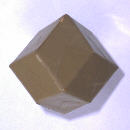 |
| Color |
Yellow,
brown, red and black is common. Darkbrown to black is the
normal. Green is rarely found.
With higher iron content the color tends to the darker
grayish brown and black. Barium gives a very nice yellow
to red Sphalerite, at least with low iron. |
| Special |
Sphalerite
is triboluminescent - it gives off light when cut or
crushed.
Sphalerite with higher iron contents stinks when cut or
crushed. The wellknown odour of rotten egg can be quite
overwhelming.
The same smell is a telltale in identifying Sphalerite,
when you put a small drop of hydrochloric acid on the
specimen. At least Iron-Sphalerites gives off hydrogen
sulphide with it's characteristic smell. |
| Inclusions |
Commonly
included. Minerals like Pyrite, Chalcopyrite, Galena and
even Silver are found. |
| Synthesis |
Sphalerite
has been made synthetic to study it's semiconducting
abilities. Pure Zinc Sulphide is white, and synthetic
Sphalerites are to. |
Now! Let's turn to faceting!
Sphalerite to me has 4 - 5 factors giving
concern in faceting.
- Sphalerite's 6 cleavages seems to be
all over.
- Sphalerite's are rather soft.
- Natural Sphalerite's are rather dark.
Light color are of course found, but rarer.
- The fourth factor - the smell - should
be of lesser concern, since the lighter Sphalerites are
low in iron, and hence smells less.
- The twinning.
If you really want to cut a Sphalerite, the
softness is a technical problem, not a great concern.
The color is as your rough gives it.
The smell when cutting is - well - as it is. You either stand up
to it, or leave it alone.
This leaves us with the cleavages - and the
twinning - as the main factor. Let's look at the rhombic
dodecahedron a litle more.
At JCrystals they've made a Java-applet of
a dodecahedron that's
good to play with.
You may also build your own in
paper or cardboard.
When you play around with the dodecahedron model it's important
to realise the basic orientations of the 2-, 3- and 4-fold axis
of the cubic system.
If you have a model in hand,
Orient it in these 3 basic orientations,
Remember the faces on the dodecahedron represents the
cleavage and Think "Orienting it for
faceting".
- You will see that rough oriented along
the 2-fold axis leaves us with a cleavage in the table
plane, which disqualifies this orientation.
- Orienting along the 3-fold axis leaves
us with 6 cleavage planes on the girdle. Not good, but if
you orient the girdle facets at skew to the cleavages,
its feasible. The cleavages slopes at a very low angle -
good because it's not likely to affect a facet.
- Orienting along the 4- fold axis
leaves only 4 cleavage planes on the girdle. Thats better
than before, but still you should orient the girdle
facets at skew. The cleavages slopes away at 45 degrees -
not good because that's our main measure of angles. But
remember the high RI allows us to go as far down as 25.5
degrees, although the general recommendation is around
40-43 degrees.
- I find that the best choice
will be to orient the rough 10 - 20 degrees off the
4-fold axis in either up-left/down-right or
down-left/up-right direction when oriented as in the
fourth picture above. This leaves us with greatest chance
of not hitting a cleavage plane with a facet. Some may
come close though.
- But orienting 10-20 degrees
off the 2-fold axis may also be workable,
although the any of the 6 cleavage planes around the
table may be close to a girdle facet.
- My third choice would be
orienting along the 3-fold axis.
Now! How
shall we find the cleavages? What we are looking for are
the mirrorlike reflections from minute cleavages on the
edges or rough surfaces of our stone. Anyone familiar
with waterworn pebles of Topaz or cabochon cutting of
Star Ruby will know the looks. When turning the stones,
you will notice the reflections from the different
cleavage planes. Mark them on your rough, and you should
be able to find the 4-fold axis - 4 cleavages like in
picture 3 above. When first you have located it, it's no
matter to tilt it the right way, and mark the table.
Then grind the table, dop up, and you are ready to facet.
|
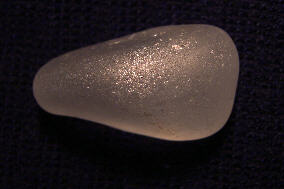 |
| Cleavage
on a Waterworn Topaz Pebble |
|
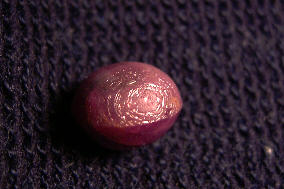 |
| Parting
on the Back of a Star Ruby |
|
| Photographing
cleavages are rather dificult. You have to capture the
reflection in the correct angle to show off the silky
sheen so characteristic of rolled Topaz pebbles. On
studying the Topaz pebble up close you may see the small
cleavages as lines and minute mirrors in the surface of
the pebble. The Topaz above is oriented almost vertical,
so you are looking directly on to the clevage plane Partings are coarser since the phenomena is
ascribed to muiltiple twinning, hence not as dominant and
penetrating as cleavage but much more brittle.
|
Twinning
With the twinning the problems with
the cleavages multiplies. In one half of the twin the
cleavage is oriented away from your cutting, in the other
half it's almost inevitable that it's against. If your
crystal is twinned, you may have to compromise on some
facets. Maybe trade off polishing parts or all of a few
facets. If you are lucky you find a direction to cut this
specific facet, that polishes both halves of the twin.
This is really time to play with reversing lap rotation
and placing the gem on the lap. Keep a detailed log of
your progress, or you will spoil the work done in
prepolish polishing.
|
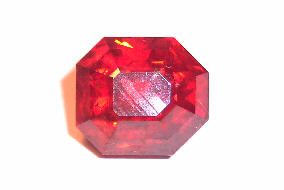 |
| Twinning
on the table of my Sphalerite |
|
Cutting Sphalerite
I guess the real or most challenging
problem with Sphalerite is really the scratching issue - that is
where that gem will make a faceter out of you. It will often
scratch, or get little tiny fragments break off a facet edge and
skate across your work and.... well, you know what happens then.
Faceting should be on the wary side. Use as
fine a mesh as possible - #600 or even less for cutting, a lot of
water and not to high speed. On the other hand I did not find it
difficult to cut Sphalerite - Calcite is worse. I polished on
acrylic with diamond - #50.000.
Oh, and pay particular attention to - use SLOW
lap speeds at all times. This IS NOT a material
that can handle higher lap speeds.
Cutting log
This is one of those gems where you would
wish you had learned yourself how to keep a log. I kept track of
facets near on cleavages, to be aware next time I came around.
And thats necessary since you will go over each facet at least 2
times, and all the good work in cutting and prepolishing can be
spoiled trying to polish for a fraction of a moment in the wrong
direction to the grain of your gem.
But start off your log before that. Try to
log down how you oriented the gem and which thoughts you had,
doing that. Dopping method etc.
Log lap type, lap speed, where you put down
the stone on the lap, if you cut it with reversed rotation, if
you used more or less pressure, small strokes or long sweeps.
Anything that might help you next time you go over that same
facet.
And maybe the most valuable use of this log
is for next time you cut a Sphalerite. This sounds maybe
elaborate, and you soon cuts down on detail cutting the ordinary
gems like quartz, but on these trouble makers like Sphalerite,
Calcite, Spodumene, Zincite or Cuprite - the more details the
better.
Dopping
You really shouldn't get Sphalerite hot
during any stage of faceting, primarily this means NO wax
dopping. Go with epoxy or cyanoacrylate, but remember that epoxy
will shrink 5% or more, so keep the bond line as thin (and small)
as possible - if you do not, you will exert considerable
mechanical stress on the gem and possibly cleave it.
However, this are just warning notes as
Sphalerite is a material like Fluorite where the cleavage is not
as bad as would be thought (or bad as it is reported in other
sources) - and most of you know that fluorite is really not that
much of a bummer in terms of cleavage - feldspar is another,
etc., but I am just saying best to be careful rather than sorry.
Laps and cutting
The greatest bit of wizardry is in choosing
the correct lap - you should use the finest lap that you can to
get the job done - start with #600, and get finer if you can.
Paul Ahlstedt has often just cut Sphalerite with a #3,000 and let
it be with it. Problem is, like Calcite, Sphalerite will give a
sort of "suction" type of feel on the lap the finer the
lap gets - and that will most often pull cleavage fragments out
of the surface of the facet you are cutting if you are not
careful.
For this reason, use light pressure, and
using the mindset behind the cleavage models, always try to cut
in a direction which compresses the cleavage planes - use your
motor reverse switch heavily here for that. This may especially
be very difficult to achieve on the table.
Paul Ahlstedt states that he has the best
luck with lots of water on a Raytech NuBond in #3,000 for all
grinding. In essence, you do the grinding and prepolishing all
with one grit. This has the advantage that the lap is so fine and
gentle, it really greatly minimizes the tendency to scratch and
so on.
My #3000 NuBond imparts what I would say is about a #8000 finish,
so it is actually pretty near a polish to begin with - subsequent
polishing is then fairly easy.
I used #600 for roughing in, and #3000 on
acrylic for prepolish.
The one problem here is that you can only
use this method on normal jewelry sized stones - if you have one
of those 100+ carat whoppers, you definately will have to default
to the #600 for rough grinding.
Polishing
When you go to polishing - I guess the
overall trick is to use light pressure, as fine laps as possible
for the application, and very slow lap speed with lots of water -
and the polishing method should produce as little friction as
possible.
Use your favorite method with high
lubricity, such as diamond or alox with extender fluid, light
oil, etc, as this material will easily scratch and abrade with
the slightest friction.
This is one gem you shouldn't use water & Linde slurry on,
although you can if you are gentle with it (use a heavy slurry).
Paul recommend using the finest diamond
that you can get away with, or you could even use alox powder b
with a lubricant other than water and that would be fine as well
- the issue here is that the more "glossy" you get the
surface, the more that material kicks butt. :-)
Note however that the longer you stay on a
Sphalerite facet polishing it, the more it will round - so get it
as fine as you can with your prepolish and then hit it as quickly
as possible to bring a good polish up and then move on to the
next facet. The best polishing laps are those that are gentle.
Plastic, and something like a resin Pol-A-Gem, Corian, Ultra-lap
(and more traditionally a wax) should all probably be good gentle
laps to use for polishing.
Also note that because of the softness, you
can still OVERCUT while you are polishing - so pay careful
attention that you keep your meets.
Clean up
A final note might be that sulfur and
sulfur compounds are NOT good for your faceting machine, so be
sure to clean up religiously after you are done.
A gem of some 10mm in diameter or greater
in a lighter body color is worth the trouble, and a great
addition to a collection - as well as being a great learning
tool.
Design for Sphalerite
As for the design try
"Sphaler-8"
on the USFG website. It's designed especially for
Sphalerite. But SRB's will also do well. I have used a
step cut which displayed the caramel brown of my rough
very well.
Your choice of design should go for simpler designs to
avoid facets closing in on the cleavages.
|
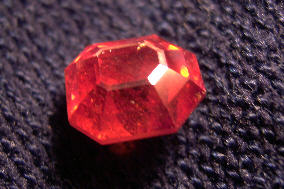 |
| Step
Cut Sphalerite |
|
On the other hand the
high RI gives you more room for playing with the pavillon
angles. Thus darker material may safely be shallower, and
still show reflectance. The dark color masks the
dispersion, hence that's no concern.
In very light material you might wish for a cut that
displays the dispersion. Go for a higher crown, or even a
BOG-optimisation of the design. But to get full advantage
of the dispersion, make sure your facets are flat. |
Aarhus, Denmark - October
27. 2005, Jón Olaf Svane with the aid and gross contributions by
Paul Ahlstedt.

